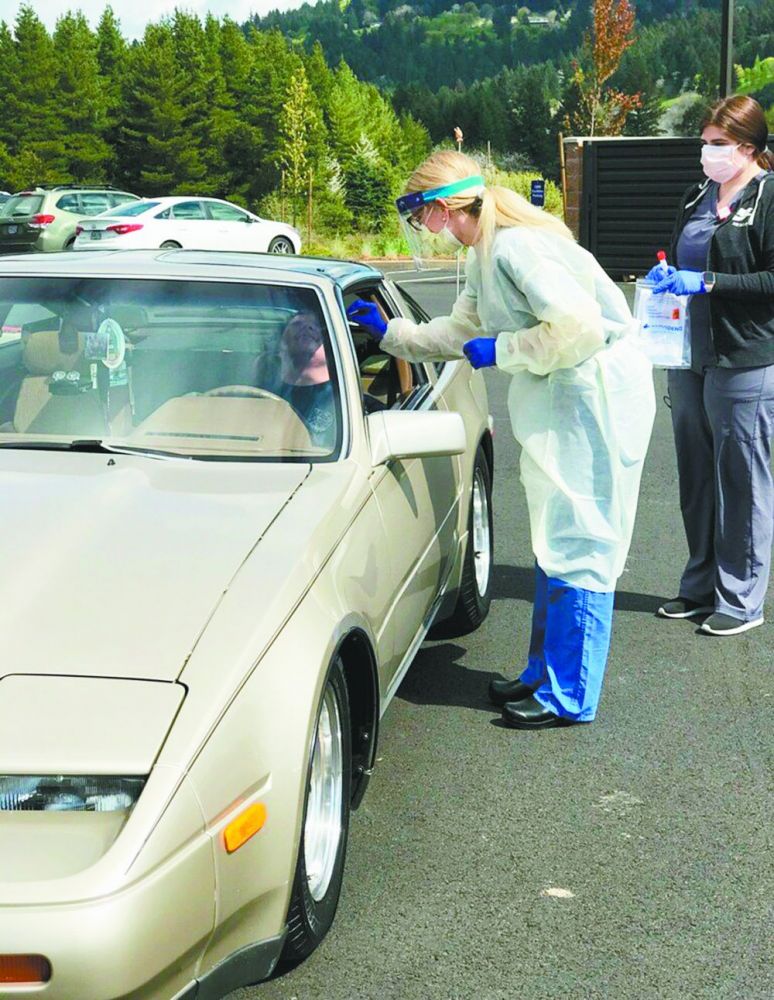New COVID-19 tests double capacity as state posts record case numbers

OHA has broadened its guidelines for who should be tested, saying anyone who has symptoms of COVID-19, regardless of the severity, should be tested, along with people in close contact with them, even if they don’t show symptoms.
The state welcomed the increased testing capacity, but said a new pair of surveys of Oregonians’ behavior suggested a more complex and worrying picture.
The surveys indicated about 84% of Oregonians are reporting wearing masks indoors and many are also taking other precautions, such as hand-washing, but many are still attending social gatherings that continue to drive the spread of the coronavirus.
Two in 10 people report gathering in groups of more than 10 people, and 66% report gathering outside in a backyard, porch or park, the survey found.
More than half of respondents reported gathering with friends inside houses.
The new rapid tests yield results in as few as 15 minutes, but must be administered by a professional or at a location that meets certain federal standards for laboratory testing.
As in other forms of COVID-19 testing, positive results are considered reliable, but false negative tests are common, even among asymptomatic individuals.
In Yamhill County, case counts continue to rise this week, with 12 more cases reported Thursday, bringing the county’s total to 844, double the number from early August. There have been 14 deaths reported in the county, though none since August.
The OHA survey of 1,000 Oregonians, conducted by DHM Research, found “more than eight in 10 report wearing masks nearly all of the time while in public indoor spaces; more than two in three avoid crowded places; and more than six in 10 are staying 6 feet apart when in public.
However, it said, “roughly half of Oregonians report attending about four or more social gatherings in the previous two weeks, and one in five Oregonians say they have attended at least one social gathering of more than 10 people in the past two weeks.”
In addition, 16% of respondents said they participated in 11 or more social gatherings in the previous two weeks. This level of social activity was most common outside of the tri-county area and the Willamette Valley, and among respondents under age 50. Oregonians who gather in larger groups also reported taking fewer protective measures.”
The OHA noted “state public health epidemiologists have pointed to social gatherings has a primary route of transmission for COVID-19 in Oregon.”
It said Latinx residents, who constitute about 40% of the state’s cases, reported higher rates of mask wearing, in a separate study conducted in Spanish by Lara Media.
In that survey, the OHA said, “about 87% of respondents report wearing a face mask nearly all of the time while in public indoor spaces; more than half avoid crowded places; and more than six in 10 are staying 6 feet apart when in public.”
The two surveys contain some information, according to OHA Director Patrick Allen, who warned that “too many people are socializing indoors in bigger groups.
“It’s hard to sustain the changes we’ve all had to make in our lives to keep ourselves and others safe from COVID-19. But we won’t be able to prevent more infections, and get more schools and businesses open in Oregon, until more people act with urgency and avoid the social super-spreader gatherings that have driven COVID-19 transmission and disease in Oregon,” Allen said.
Because false negatives are common with testing, health officials cautioned those who test negative should continue to exercise caution.
“Even if you have a negative test, it’s important to wear a mask, stay physically distant from other people (especially older people or those with underlying medical conditions), avoid large gatherings and wash your hands thoroughly,” OHA public health physician Dr. Melissa Sutton said.
OHA said it will prioritize testing for communities affected by wildfires, and those hardest hit by COVID-19, including migrant and seasonal farmworkers, communities of color and tribal communities and residents of congregate care settings.
Plans call for expanding testing to students and staff at schools and Oregon’s colleges and universities through school-based health centers and other community partners.
Some tests will be maintained as a strategic reserve to ensure a supply beyond December (when the current allocation is scheduled to end) and to be used to contain any major county outbreaks.








Comments